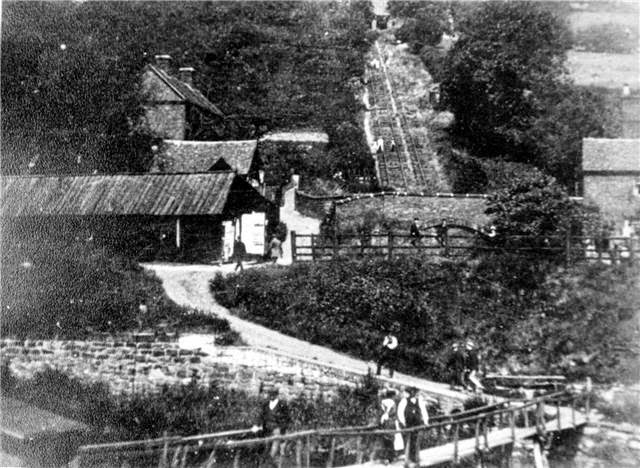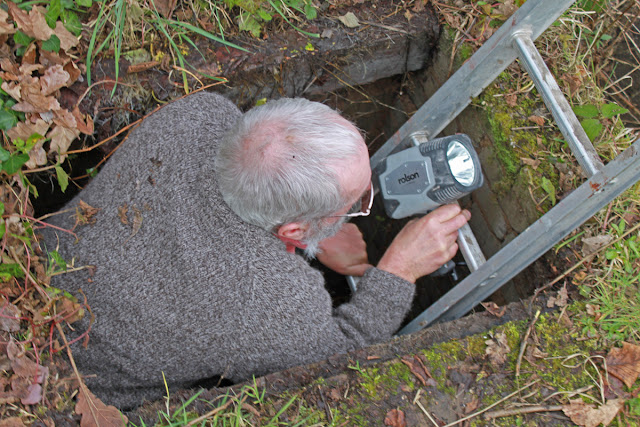Shropshire Canal
Horsehay Branch - Brierly Hill Incline
March 2012
In some ways this post is about an incline that isn't.
Brierly Hill Incline
Confused? Well I am referring to the inclined plane at the end of the Horsehay Branch which provided access to Abraham Derby's Coalbrookdale Ironworks. Strictly speaking it isn't part of the canal network as it carried one ton loads which had already been transshipped from the tub boats rather than a plane which carried the boats themselves. I therefore don't count it as one of the six tub boat inclined planes of the Shropshire Canal network, but the whole transshipment set up was very unusual and deserves a post of its own.
The remains of the westernmost loading bay
Lets start with Charles Boyce without whom the Horsehay Branch series would have ended with my last post. Charles owns Old Wynd, the building which appears to have formed part of the site from its industrial days 200 years ago, plus the garden and woodland which make up the overall site. Not only is he the landowner but he is also a passionate historian about the incline, and an avid boater - a pretty compelling mix!
Remains of the plateway recovered from the site.
Having bought the site years ago he became aware of the features it contained and, armed with a JCB, proceeded to excavate large areas in search of artifacts - a one man time team if you like! Bit by bit he unearthed the story till he had built a probable sequence of events which he generously shared with me.
Views of the incline - from the top and the bottom.
My history lite version of events is as follows:
The terminus would have been built in or around 1792, at a reputed cost of £2,000, which was more than a small fortune at the time. So, why so expensive?
Well, it is known that before the inclined plane was built, the connection to the factories of Coalbrookdale were reached via two ten foot diameter vertical shafts which descended into a lateral tunnel 120 feet below.
Images from Reynolds note book show four loading bays into which sub boats were maneuvered and from which loads were taken and let down one of the shafts, with the same rope lifting an empty carrier up the other one, all operated by gravity. From the bottom of the shafts the goods would have been wheeled out and away, quite possibly to the flat area near the reservoir which was probably created from the spoil excavated in the tunnel's creation. The presence of the shafts has been proven by Charles but the whereabouts of the tunnel entrance is pure conjecture.
Innovative as this arrangement was, it does not seem to have been entirely successful and alternative mechanisms were considered but, as was the case at Lilleshall, it was eventually abandoned in favour of an Inclined Plane. Ok so far, but the twist is that the documentary evidence suggests that at least for a time the shafts and the incline operated simultaneously. The evidence on the ground support this idea but its not obvious at first glance.
The shaft into the tunnel
For a start all inclines need to be at a constant gradient, but the route down the hill has a kink, descending at 15 degrees lower down but only 9 degrees at the top end. The assumption, confirmed by the old maps, is that the incline was on the lower section and that a tramway led down the shallower gradient at the top. So how did a tram get past the congested lifts site which stood like a sheer cliff as the top of the slope? Answer - through the tunnel found buried 20ft below Charles garden. The cargoes would have been unloaded at the newer Old Wynd Cottage and then wheeled under the canal basin via the tunnel, and on down the hill to the top of the incline. Again, this is all conjecture but the story seems to fit the facts.
Charles descending into the pit
The canal itself was short lived, with the Coalbrookdale end abandoned by 1802, less than 10 years after its construction, by which time a tramway had been built along its towpath. The rest of the Horsehay Arm was soon to follow and was fully abandoned by 1825. Therefore, the remains we see today are nearly 200 years old and reflect a canal which, in part, worked for less than a decade.
The tunnel beneath the garden
In its last incarnation the canal had been removed and instead of taking the tramway through a small tunnel, the tub boat docks and part of one of the shafts were removed to allow the tramway to pass right through the middle of the site, destroying much of the built remains in the process.
Charles - we ran through all the history at quite a lick - did I get it about right?
Many thanks for the tour.


























































